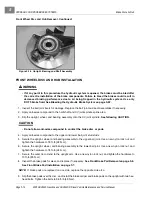
HYDRAULIC AND PARK BRAKE SYSTEMS
Master Cylinder and Reservoir
2005 HUV4420 Gasoline and HUV4420-D Diesel Vehicle Maintenance and Service Manual
Page 5-21
5
MASTER CYLINDER REMOVAL
ý
WARNING
• To perform this procedure, the hydraulic system must be opened. As a result, the brakes must
be bled after the correct reinstallation of the brake components. Failure to bleed the brakes
could result in decreased braking performance due to air being trapped in the hydraulic
system. Use only DOT 5 brake fluid. See Bleeding the Hydraulic Brake System on page 5-22.
1. Chock the wheels, and set the park brake.
2. Remove the top screw caps and screws from the dashboard and front body.
3. Remove the front body.
See Front Body Removal, Section 4, Page 4-5.
4. Remove the hoses from the master cylinder.
See following NOTE.
NOTE:
Use a clean container to collect the brake fluid. After both hose ends have been placed in a con-
tainer, remove the reservoir cap, and allow fluid to drain freely from the reservoir container.
If hoses are cracked or show signs of deterioration, replace them with approved hoses designed to
handle the brake fluid specified for this vehicle.
5. Use a flare-nut wrench to remove the front and rear brake lines from the master cylinder.
See following
NOTE.
NOTE:
Use a clean container to collect the brake fluid.
6. Remove the rue pin and clevis pin from the brake pedal and push rod clevis
(Figure 5-21, Page 5-21)
.
7. Remove the two bolts and lock nuts that secure the master cylinder to the frame.
8. Remove the master cylinder from the vehicle.
Figure 5-21 Master Cylinder Rod and Brake Pedal
Summary of Contents for HUV4420
Page 1: ... 5 5 2 4 56 56 3 3 6 3 4 3 26 5 ...
Page 2: ......
Page 16: ...Page xiv 2005 HUV4420 Gasoline and HUV4420 D Diesel Vehicle Maintenance and Service Manual ...
Page 20: ...1 ...
Page 38: ...4 ...
Page 68: ...5 ...
Page 74: ...6 ...
















































